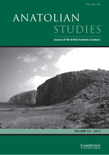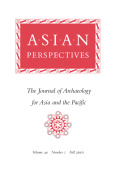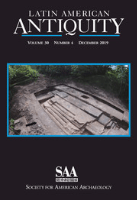
Anatolian Studies
Scope & Guideline
Illuminating the Richness of Anatolian History
Introduction
Aims and Scopes
- Archaeological Research:
The journal publishes articles that present new archaeological findings, site interpretations, and methodologies, emphasizing the importance of material culture in understanding past societies. - Cultural and Historical Analysis:
Anatolian Studies features research that provides insights into the social, political, and economic structures of ancient Anatolian civilizations, including their interactions with neighboring cultures. - Art and Architecture Studies:
The journal explores the artistic and architectural achievements of various periods in Anatolia, analyzing their significance and influence on broader Mediterranean and Near Eastern trends. - Interdisciplinary Approaches:
Research published in the journal often employs interdisciplinary methodologies, merging archaeology with history, art history, anthropology, and other fields to provide a comprehensive understanding of the past. - Regional Studies:
The journal covers various regions within Anatolia and adjacent areas, focusing on specific archaeological sites, historical developments, and cultural identities.
Trending and Emerging
- Gender and Identity in Antiquity:
Recent articles increasingly examine the roles of gender and identity in ancient societies, exploring how these factors influenced social structures and cultural practices. - Urban Development and Archaeology:
There is a growing focus on the urban development of ancient cities, particularly in relation to their chronological and spatial transformations, as seen in studies of Hattusa and other urban centers. - Scientific Techniques in Archaeology:
The application of scientific methodologies, such as chemical analysis and spatial autocorrelation, is on the rise, enhancing the understanding of archaeological contexts and material culture. - Religious Practices and Material Culture:
Emerging research highlights the relationship between religious practices and material culture, particularly in the context of Byzantine and Early Christian archaeology. - Cross-Cultural Interactions:
The exploration of interactions between various cultures, such as the Hellenistic and Roman influences in Anatolia, is increasingly prominent, reflecting a broader interest in globalization in the ancient world.
Declining or Waning
- Medieval Studies:
Research focusing specifically on the medieval period in Anatolia has decreased, possibly due to a growing interest in earlier periods or more contemporary themes. - Persian Influence:
While previously a topic of interest, studies examining the Persian presence and influence in Anatolia are appearing less frequently, suggesting a potential shift towards indigenous narratives. - Textual Analysis of Inscriptions:
The analysis of inscriptions, particularly from the Hellenistic and Roman periods, has seen a decline, possibly due to the journal's shift towards more archaeological and material studies. - Traditional Pottery Studies:
Research on traditional pottery styles and classifications appears less frequently, as the focus has shifted to more complex analyses involving chemical and technological approaches. - Local Myths and Legends:
Themes surrounding local myths and legends of ancient Anatolian cultures seem to be diminishing, reflecting a move towards more empirical and evidence-based research.
Similar Journals

Aula Orientalis
Fostering Dialogue in Archaeology and HistoryAula Orientalis, an esteemed academic journal published by the Universitat de Barcelona's Institute of Ancient Near Eastern Studies, serves as a vital platform for scholarly discourse in the field of Near Eastern Archaeology, History, and Philology. With an ISSN of 0212-5730, this journal aims to disseminate high-quality research, fostering a deeper understanding of the ancient Near East through the publication of articles, reviews, and discussions by leading experts and emerging scholars alike. Although the journal has undergone changes in its indexing status, it continues to maintain a focus on rigorous academic standards and relevance in the global research community. Positioned at the crossroads of history and archaeology, Aula Orientalis encourages interdisciplinary collaboration and is ideal for researchers, professionals, and students seeking to expand their knowledge and engage with contemporary issues in ancient studies.

OLBA
Unearthing Insights into Ancient CivilizationsOLBA is a distinguished journal in the field of archaeology, published by Mersin University Publications Research Center Cilician Archaeology in Turkey. With an ISSN of 1301-7667, this academic journal has been a platform for scholarly discourse from 2009 to 2014 and again from 2016 to 2019, with a recent volume published in 2022. Although it is currently categorized in the fourth quartile (Q4) for both Arts and Humanities and Social Sciences within archaeology, OLBA continues to contribute significantly to the global archaeology community. It serves as an essential resource for researchers, professionals, and students interested in the diverse aspects of archaeological studies and cultural heritage. Despite not being an open-access journal, OLBA strives to disseminate knowledge effectively, aiding in the exploration of ancient civilizations and the rich tapestry of human history. Its Scopus rankings, placing it in the bottom percentiles, demonstrate the ongoing need for the community to support and engage with the journal to enhance its visibility and impact in the archaeological domain.

Asian Perspectives-The Journal of Archaeology for Asia and the Pacific
Advancing Knowledge: Illuminating Archaeological HeritageAsian Perspectives - The Journal of Archaeology for Asia and the Pacific is a prestigious journal published by University of Hawaii Press, focusing on the intricate field of archaeology in Asia and the Pacific. With a rich publication history dating back to 1993, the journal has established itself as a vital platform for disseminating research that illuminates the archaeological heritage and cultural dynamics of this diverse region. Recognized for its scholarly impact, it enjoys a commendable impact factor and ranks in the Q2 category for Anthropology and Archaeology, indicating its significant contribution to these fields. Although it operates on a traditional subscription-based model, the journal is accessible to institutional and individual subscribers worldwide. With an emphasis on interdisciplinary research, Asian Perspectives invites contributions that foster a deeper understanding of historical and contemporary issues through archaeology, making it an invaluable resource for researchers, professionals, and students alike committed to advancing scholarly dialogue in the region. Explore a wealth of innovative studies and insights that continue to shape the understanding of Asia and the Pacific's archaeological narrative.

Journal of Ancient Near Eastern History
Decoding History Through Archaeological InsightsJournal of Ancient Near Eastern History, published by Walter de Gruyter GmbH, is a pioneering platform dedicated to the exploration and analysis of the ancient Near East, spanning topics such as archaeology, history, and cultural studies. With its ISSN 2328-9554 and E-ISSN 2328-9562, this journal engages a diverse audience of researchers, professionals, and students who are eager to deepen their understanding of this historically rich region. Although currently not an open access journal, its rigorous peer-review process ensures that each publication maintains high scholarly standards. Aimed at fostering interdisciplinary dialogue, the Journal of Ancient Near Eastern History serves as an essential resource for anyone interested in the complexities of ancient civilizations, their legacies, and their relevance in contemporary society. With a commitment to advancing scholarship in this field, the journal is poised to contribute valuable insights and foster critical discussions among historians and archaeologists alike.

Gerion-Revista de Historia Antigua
Bridging Eras: Where Scholarship Meets the Ancient WorldGerion-Revista de Historia Antigua is a prestigious academic journal published by UNIV COMPLUTENSE MADRID, SERVICIO PUBLICACIONES. Since its inception in 1983, this Open Access journal has been a vital platform for researchers and scholars in the fields of Archaeology, History, and Classics. Based in Madrid, Spain, the journal promotes rigorous scholarship and dissemination of knowledge covering a broad spectrum of ancient history and artifacts. With its impressive quartile rankings—Q1 in Classics and Q2 in both History and Archaeology—Gerion demonstrates a strong commitment to academic excellence, boasting a respectable presence within Scopus rankings. Researchers will find a collaborative space here, as the journal aims to support interdisciplinary dialogue and foster a deeper understanding of ancient civilizations. With its dedicated approach to quality and accessibility, Gerion is essential for anyone engaged in the study of our historical past, making it a valuable resource for students, professionals, and academics alike.

ARCHAEOLOGY
Unraveling Mysteries, Enriching KnowledgeARCHAEOLOGY is a distinguished peer-reviewed journal published by the Archaeological Institute of America, focusing on the multifaceted aspects of archaeological research and its relevance to contemporary society. Established in 1966, this journal serves as a critical platform for scholarly discourse in the field, showcasing innovative findings, theoretical advancements, and methodological discussions related to archaeology. While it maintains a Q4 ranking within the disciplines of archaeology and arts and humanities, its contributions remain valuable for those engaging in archaeological studies or seeking to understand historical and cultural narratives. The journal is accessible in print, with an ISSN of 0003-8113 and an E-ISSN of 1943-5746, ensuring that a wide audience can benefit from its insights. Although currently not classified as Open Access, the meticulous peer-review process ensures a high standard of academic rigor, making it an essential source for researchers, professionals, and students alike who are dedicated to exploring the past through archaeological lenses.

LATIN AMERICAN ANTIQUITY
Exploring Pre-Columbian Cultures and Ancient CivilizationsLATIN AMERICAN ANTIQUITY is a prestigious journal published by Cambridge University Press, focusing on the archaeology and history of Latin America. With an impressive impact factor reflecting its critical role in the academic community, this journal exemplifies excellence in research, landing in Q1 across multiple categories, including Archaeology and History, as per the 2023 category quartiles. The journal's scope covers a broad range of topics related to pre-Columbian cultures, ancient civilizations, and historical developments, making it essential reading for researchers, professionals, and students keen on exploring the rich tapestry of Latin American heritage. Although it is not an open-access publication, LATIN AMERICAN ANTIQUITY remains a vital resource for those dedicated to advancing knowledge in this dynamic field. With its commitment to scholarly rigor and a strong ranking in Scopus, it serves as a cornerstone for academic dialogue and investigation.

AMERICAN JOURNAL OF ARCHAEOLOGY
Bridging Time: Where Archaeology Meets InnovationThe American Journal of Archaeology (ISSN: 0002-9114, E-ISSN: 1939-828X), published by the esteemed University of Chicago Press, stands as a leading scholarly journal in the field of archaeology, celebrated for its rigorous peer-reviewed research. With an impressive impact factor that places it in the Q1 quartile for both archaeology and archaeology within the arts and humanities, this journal ranks among the top 15% in its field, according to Scopus metrics. It serves a global audience of researchers, professionals, and students, facilitating the dissemination of innovative findings from excavations, historical analyses, and methodological advancements. While primarily available through subscription, the journal's archives and features provide invaluable resources for deepening one's understanding of the past and engaging with current archaeological discourse. Operating from its home in Chicago, USA, the American Journal of Archaeology actively contributes to the advancement of knowledge and scholarship in archaeology, making it an essential platform for those invested in the exploration of ancient civilizations and cultural heritage.

Drevnyaya Rus-Voprosy Medievistiki
Bridging Past and Present through Rigorous ResearchDrevnyaya Rus-Voprosy Medievistiki is a prestigious journal published by INDRIK that focuses on the rich tapestry of medieval studies, particularly centered around the history and culture of Ancient Rus. With its ISSN 2071-9574, this journal aims to contribute significantly to the academic discourse surrounding medieval historiography, archaeology, and cultural studies through original research, comprehensive reviews, and scholarly articles. Although it does not currently operate under an open access model, Drevnyaya Rus remains a vital resource for researchers and students interested in the complexities of medieval civilization. Located in Moscow, Russia, the journal seeks to foster a deeper understanding of Eastern European history and its implications on contemporary society. By providing a platform for rigorous scholarship, it plays a crucial role in expanding the knowledge base within the field of medieval studies, thereby catering to the interests of historians, archaeologists, and cultural theorists alike.

JOURNAL OF MEDITERRANEAN STUDIES
Connecting Cultures through Mediterranean ScholarshipJOURNAL OF MEDITERRANEAN STUDIES, based at the Mediterranean Institute, University of Malta, serves as a vital platform for scholarly discourse within the fields of anthropology, cultural studies, and the broader arts and humanities. Established with the aim of exploring the rich tapestry of Mediterranean cultures and societies, this journal offers an invaluable resource for researchers, professionals, and students alike. Although it operates under a traditional subscription model, the journal ensures comprehensive accessibility to its diverse range of articles, enhancing the visibility of Mediterranean studies. With an ISSN of 1016-3476 and E-ISSN 2523-9465, it garners attention across various academic ranks, notably a Q4 classification in multiple categories as per the 2023 evaluation, indicating its unique contributions to these disciplines despite its emerging status. As researchers delve into its volumes, they are invited to engage with a wealth of interdisciplinary insights that illuminate the Mediterranean’s complex social and cultural dynamics.